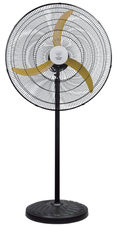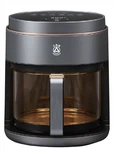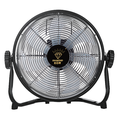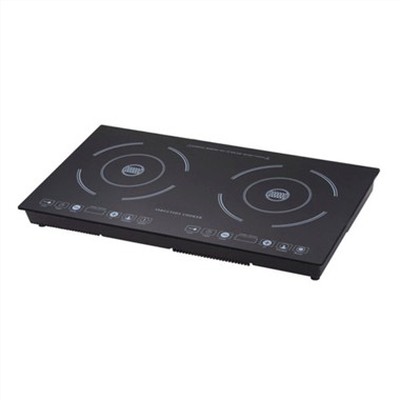Induction Cooker
What is Induction Cooker
An Induction cooker is a type of cooker that uses electromagnets for cooking. An induction cooktop typically uses copper coils. These coils can produce a magnetic current with the pot or pan on the top of the surface. In an induction cooker, the heat passes directly to the cooking pot rather than heating up the surface of the cooktop, unlike in an electric cooktop. This makes the pot or pan heat evenly. This also ensures a smaller energy loss during the cooking process.
Benefits of Induction Cooker
Increased Responsiveness
Induction cooktops cut out the added step of first heating up the heating element that then heats up the cookware. Instead, the electromagnetic currents heat up the pan itself which leads to fast changes in temperatures, for more precise cooking.
Precision Control
Induction cooktops heat up the entire bottom surface of the pan quickly and they have fast response times to temperature change, so you can go from a boil to a simmer in a shorter amount of time.
Easy Clean Up
Since the surface of an induction cooktop does not generate its own heat, it stays relatively cool compared to a radiant electric cooktop. If spillage occurs when cooking your favorite sauces or meals, the cooler surface can reduce baked-on, charred spills or burnt-on grease stains. Some heat can transfer from the pans to the cooktop, so be sure to allow the cooktop to cool completely before cleaning. Follow the steps for how to clean an induction cooktop in our helpful guide to keep your cooktop looking and performing at its best.
Why Choose Us
Customer Satisfaction
Providing after-sales services can enhance customer satisfaction by ensuring that customers' needs are met even after the purchase. This can lead to increased customer loyalty and positive word-of-mouth referrals.
Rich Experience
Has a long-standing reputation in the industry, which makes it stand out from its competitors. With over many years of experience, they have developed the skills necessary to meet their clients' needs.
Efficient And Convenient
The company has established marketing networks around the world to provide high-quality services to customers in an efficient and convenient manner.
Professional Service
We can accept factory inspection and goods inspection at any time. Technical discussion, research and development of new products, and complete after-sales service.
High Quality Products
We always put customer needs and expectations in the first place, refine on, continuous improvement, to seek every opportunity to do better, to provide customers with their expectations of quality products, to provide customers with the most satisfactory service at anytime.
Quality Control
All goods will undergo strict quality inspection before shipment. MCC always insists on providing high-quality products. We firmly believe that quality is the basis of everything.
Types of Induction Cooker
Single Induction Cooker
This is the most basic type of induction cooker, usually an independent single-mouth design, suitable for single-person or small family use, simple and easy to operate.
Multi-head Induction Cooker
This type of induction cooker has multiple independent heating areas, and can use multiple pots for cooking at the same time, which is suitable for situations where multiple dishes need to be processed at the same time, such as in commercial kitchens.
Embedded Induction Cooker
This induction cooker design can be embedded in the kitchen countertop or cabinet, making the entire kitchen look neater, usually with touch screen control and integrated appearance.
Portable Induction Cooker
Suitable for occasions that need to be carried or used in different places, portable induction cookers are usually lightweight and portable, easy to store and carry.
Induction Cooker + Gas Stove Combination
Some kitchen equipment is designed with a combination of induction cooker and gas stove, so that the kitchen can choose to use induction cooker or gas stove according to different needs.
Built-in Induction Cooker
This induction cooker is designed to be embedded in the kitchen equipment as a whole, usually integrated with kitchen equipment such as ovens, making the kitchen layout more compact.
Smart Induction Cooker
Some induction cookers have smart control functions, which can be remotely controlled by mobile phones or smart home systems, set up cooking reservations, etc.
Medium And High Frequency Induction Cooker
Compared with traditional low frequency induction cooker, medium and high frequency induction cooker usually has higher heating efficiency and faster heating speed.

If you' re buying a new cooktop and wondering ‘how do I know if my cooktop is induction,' check the manufacturer' s information to see what kind it is. Otherwise, there isn't much visual difference between induction and electric cooktops with a ceramic-glass top. Both feature a smooth surface with outlined rings to indicate cookware placement. The heating elements on some electric cooktops may glow while induction cooktops will not.
To check, turn on the stove or cooktop without any cookware on top. If the surface heats up significantly or begins to glow, it' s a traditional electric cooktop. If it doesn' t get hot or glow, or only warms slightly, it' s an induction cooktop. Induction cooktops may produce a small amount of heat without cookware, but not enough to cook food.
The real difference is in how the cooktop heats, and induction and electric cooktops may have different installation requirements. Check the manufacturer' s details for more information on installation.
Parts Of An Induction Cooktop
Cooking Surface
Typically made of a glass-ceramic material, the cooking surface of an induction stove is a poor heat conductor. Hence, most heat remains on the cooking pot instead of getting transferred through the bottom to the surface. This gives induction cooktops one of their best USPs – the surface remains substantially cooler and can be safely touched.
A ceramic top induction stove uses a lot of energy to heat up the cooking zones, while glass top induction hobs are more energy efficient and durable. The cooking surface of an induction stove is extremely smooth, making it very easy to clean.
Induction Coil
Also known as the spark coil, the induction coil is the soul of induction stoves. It works on the principle of mutual induction that generates heat on the cookware by changing electromagnetic fields.
The induction coil of induction cooktops is made of copper and is located underneath the cooker surface. When a pot is placed over the cooking zone, the stove converts the electrical energy to heat energy by the induction coil to the cooking pot.
Temperature Sensor
A temperature sensor is a safety measure to ensure that the cookware does not overheat. Placed in contact with the underside of the glass cover plate of the stove, it senses the temperature in the heating area where the cooking vessel is placed over the magnetic coil.
DC Fan
While not as much as gas or electric stoves, induction stoves need ventilation. Steam, grease, residual heat, and smoke are bound to be produced while cooking. The cooling fan provides ventilation and prevents such residues from building up in the internal system.
DC fan or the cooling fan' s aim is also to help minimize the damage to the internal system of the stove. With its assistance, the control boards remain safe from overheating.
Control Panel
Induction stoves have a control panel instead of knobs like gas stoves. The control panel can be of three types: touch control, button control, and gesture control. It also features a small display where the temperature, cooking mode, and time are displayed.
Power Settings
The number of power settings generally corresponds to the level of precision and temperature control. For context, most induction cooktops offer at least 10 power settings.
Control Panel Type
Though digital interfaces are the norm, induction controls can range from knobs to an LCD touchscreen or sliding bar or wheel you operate with the tap of a finger.
Cooking Surface Area
Cooktops come in varying sizes (24 inches, 30 inches, and 36 inches) with two or more cooking zones of differing sizes to accommodate a range of pots and pans. Some high-end models feature a flex zone or full-surface cooking to heat cookware across multiple zones (like a griddle) or anywhere on the cooktop, respectively.
Preset Options
Some home chefs might favor induction models that come with automated presets to perform specific cooking methods, such as braise, steam, or boil, as well as the option to create your own custom presets.
Safety Features
While induction is a safer cooking method, some models carry additional safety features like controls with child locks and sensors that' ll automatically turn off the heat if a pot spills over or foreign objects are detected on the cooktop surface.
Oven Function
Induction stoves with ovens offer similar capabilities to electric ovens, and may include more advanced features like convection, self-cleaning mode, and warming drawers.
Wi-Fi Connectivity
Modern, Wi-Fi-enabled cooktops can be paired with a mobile app to receive updates on new features and diagnostics for repairs or maintenance.
How to Cook on an Induction Cooktop
Turn on the cooktop
To get started, press the Power button on your cooktop' s control panel. The indicator light above the control panel will signal that you' ve properly turned the appliance on.
Place compatible cookware on heating element
Induction cooktops require compatible cookware made of ferromagnetic materials like enameled steel, cast iron and stainless steel designed for induction cooking to function properly.
Like material, the size of your pan is also crucial to achieving the best results. Choose compatible cookware that has a base diameter equal to the size of the heating element you plan to use.
Turn on the surface cooking area
Select the cooking area you want to use, then turn it on using the cooktop control panel. A power level indicator light should light up and a timer will begin, indicating that the surface is ready for you to select a cooking function.
On most induction cooktops, the power will automatically turn off after one minute of inactivity, so be sure to swiftly make your selections.
Select a cooking function
Using the control panel, select a heat setting. Consult your owner' s manual for model-specific information about your cooktop' s heat settings and functions.
Now that your induction cooktop is all set to heat, you' re ready to get cooking. Since induction cooktops heat quickly, be sure to closely monitor your food for doneness to prevent burning or overcooking.
Turn off the cooktop
Once you' ve finished cooking your meal, press the ON/OFF button to turn off your surface cooking area, then press the power button to turn off the cooktop. Before you begin to clean up, check the display for the Hot Surface Indicator. This indicator light will illuminate if the surface area is too hot to touch, even after the cooktop has been turned off.
Properly cleaning an induction stove after every use is the best way to maintain your cooktop, keeping it safe and looking good. Dried or cooked-on food can lead to scratches or abrasions on the glass surface, degrade the cooktop, and decrease its lifespan.
After each use, allow the cooking surface to cool and give it a quick wipe with a damp towel, making sure to pick up any particles that may have fallen during cooking. For an additional layer of cleanliness, you can add a few drops of dish soap to a towel or the soft side of a sponge and give the surface a good wiping.
For cooked-on spills or tougher messes, there are commercial products sold specifically for this purpose. If you don't happen to have one of these on hand, a great alternative is probably already in your kitchen. Start by lightly wetting the surface and then sprinkling a couple of teaspoons of baking soda over top. Lightly scrub with a soft sponge or microfiber cloth, and then add a splash of white vinegar (a spray bottle filled with vinegar is especially useful here). Once the fizzing subsides, give it one more pass with the sponge or cloth. Finally, wipe clean with a wet towel and dry thoroughly.
Our Factory
Established in 1956, Guangdong Triangle Electrical Appliances Holdings Ltd. (GDTRI) has been standing by the prosperous & beautiful Pearl River for over half century. As one of the earliest professional import & export companies in China, we become an international trade group company which combined with home appliance brands management, import & export, domestic trade, warehousing & logistics. Also, we are one of the advanced companies for high quality and effectiveness in international business, one of the best 500 companies in China, and one of the best 100 companies in Guangdong.

Certifications
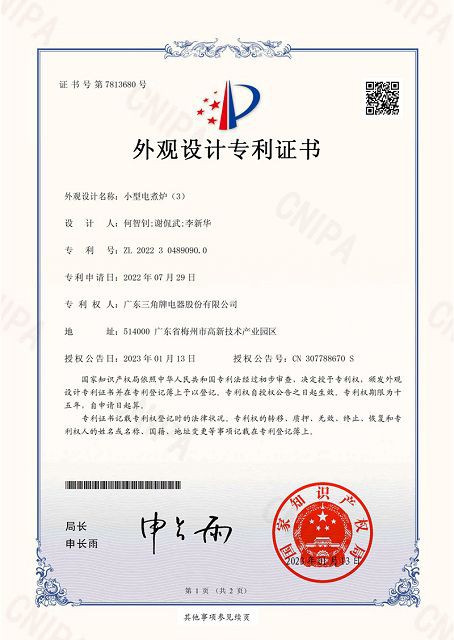
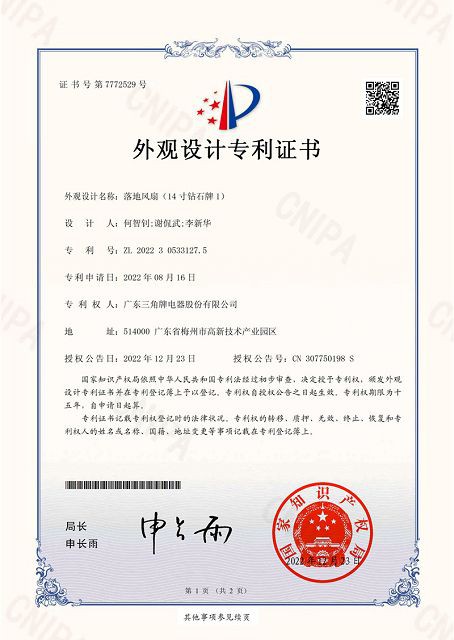




FAQ
We're well-known as one of the leading induction cooker manufacturers and suppliers in China. With abundant experience, our factory offers high quality induction cooker made in China with competitive price. Welcome to contact us for wholesale service.
Electric Rice Cooker, Multi Function Soup Maker For Cold Drinks and Hot Drinks, Input Water Pressure Meter Water Purifier WS RO022 M


